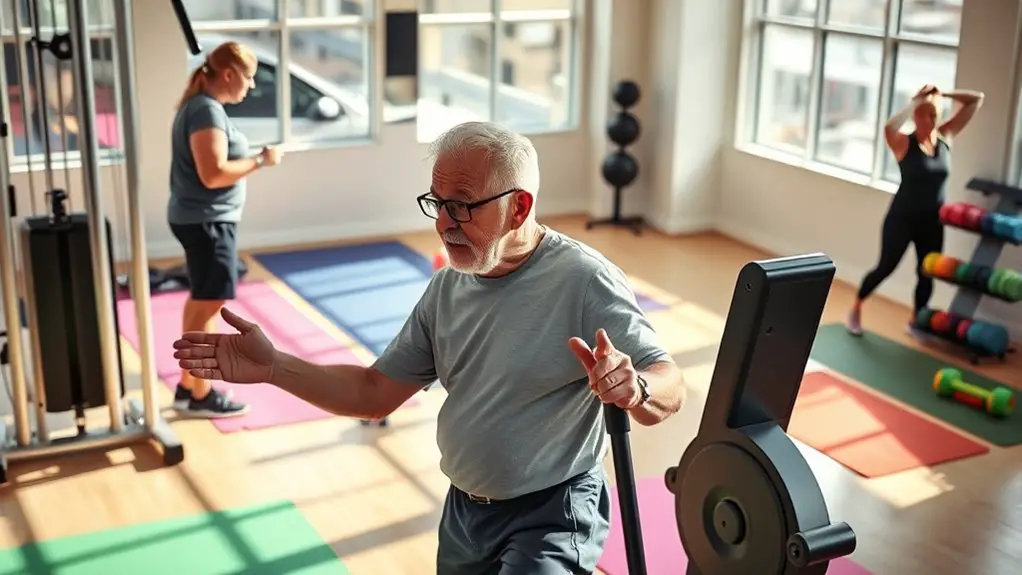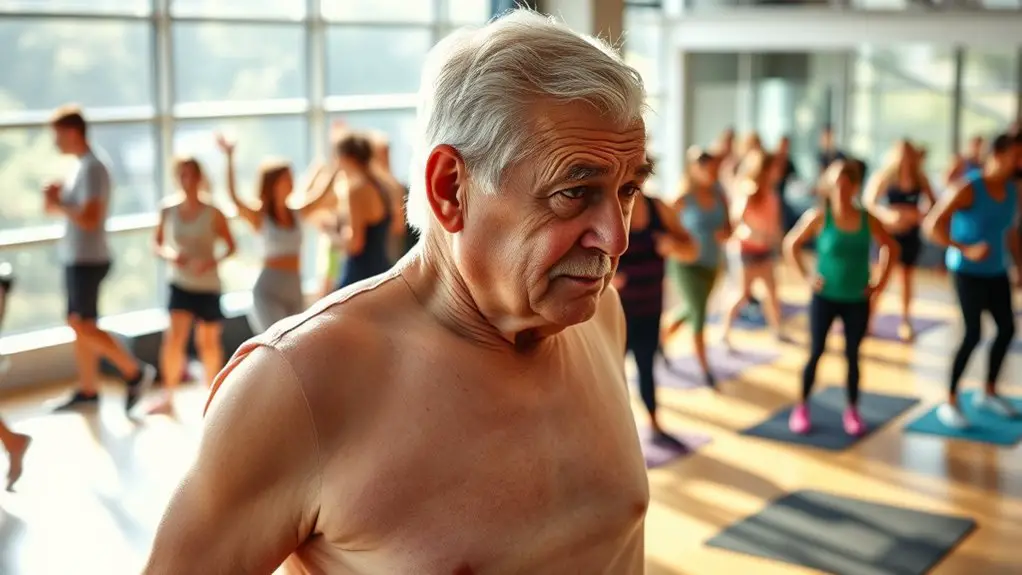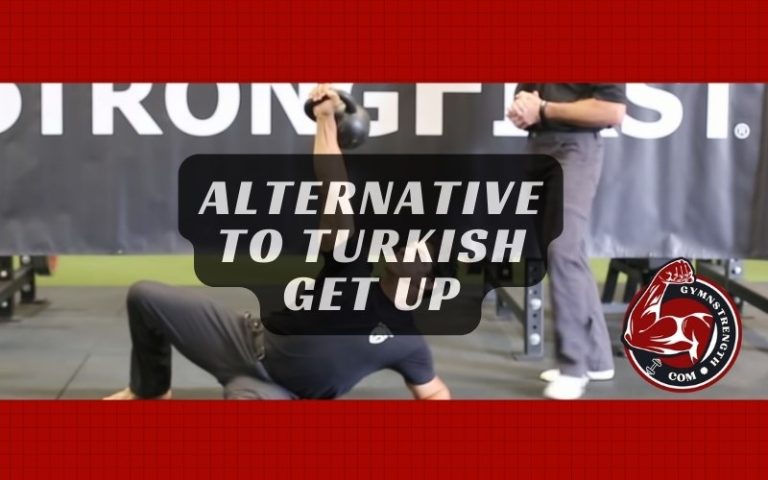Common Mistakes Older Adults Make in the Gym

Many older adults make common gym mistakes that can lead to injuries and hinder progress. You might skip warm-ups, overestimate your abilities, or neglect strength training, focusing only on cardio. Ignoring rest and recovery days is also a pitfall. Ultimately, not seeking professional guidance can leave you working without a tailored plan. Understanding these pitfalls is important for a safer, more effective workout. Learn more about how to optimize your fitness journey and avoid these mistakes.
Ignoring Proper Warm-Up and Cool-Down Routines

Many gym-goers underestimate the importance of proper warm-up and cool-down routines, thinking they can skip these steps without consequences. However, neglecting them can lead to injuries that set you back. Before diving into your workout, incorporating dynamic stretching is essential. These movements increase blood flow to your muscles, enhance flexibility, and prepare your body for physical exertion. Think leg swings, arm circles, and torso twists—these get your heart rate up and joints ready.
Equally important is the cool-down phase. After your workout, cooldown techniques like gentle stretching help your body shift back to a resting state, reducing muscle stiffness and soreness. It’s a simple step that can make a big difference in recovery. By prioritizing these routines, you’re not just improving your performance; you’re also investing in your long-term health and safety. So, don’t skip them—your body will thank you!
Overestimating Physical Abilities
While it’s great to be ambitious, overestimating your physical abilities can lead to serious setbacks in the gym. Many older adults jump into challenging workouts without a proper fitness assessment, which can result in injuries that sideline your progress. It’s essential to recognize your current fitness level and set realistic goals that align with it.
By pushing yourself too hard, you not only risk injury but also hinder your overall fitness journey. Focus on gradual progression instead. Incorporate exercises that build strength and flexibility without overwhelming your body.
Listening to your body is vital; if something doesn’t feel right, it’s okay to scale back. Prioritizing injury prevention is key to enjoying a long and fulfilling gym experience. Remember, it’s better to take things slow and safe than to rush and risk setbacks.
Neglecting Strength Training

Neglecting strength training can undermine your overall fitness goals, even if you focus on cardio and flexibility. You might not realize that incorporating strength training into your routine is crucial for maintaining muscle mass, especially as you age. The strength training benefits extend beyond just building muscle; it also enhances bone density, improves balance, and supports joint health.
When you engage in strength training, you’re not just lifting weights; you’re also empowering your body to perform everyday activities with ease and reducing the risk of injury. Start with light weights or resistance bands, and focus on proper form to guarantee safety. Aim for two to three sessions a week, targeting all major muscle groups. Remember, it’s never too late to start, and the positive changes you’ll experience can greatly enhance your quality of life. Prioritize strength training to support your overall fitness journey.
Focusing Solely on Cardio
If you’re only hitting the treadmill and skipping strength training, you might be missing out on key benefits. Balancing cardio with resistance workouts can boost your overall fitness and help build muscle. Let’s explore why incorporating strength training into your routine is essential. Additionally, progressive overload during strength training is necessary for muscle development and can lead to significant gains in strength and endurance.
Importance of Strength Training
Many beginners often overlook the importance of strength training, focusing solely on cardio to achieve their fitness goals. However, incorporating strength training is vital for maintaining functional fitness, especially as you age. Age-related changes can lead to muscle loss and decreased bone density, making you more vulnerable to injuries. By engaging in strength training, you help counteract these changes, improving your balance and stability. It also enhances your ability to perform everyday activities safely. You don’t have to lift heavy weights; even light resistance exercises can be effective. Prioritizing strength training alongside cardio can lead to a more balanced fitness routine, ultimately supporting your long-term health and well-being. Remember, safety and consistency are key!
Balancing Cardio and Resistance
While it’s easy to get caught up in the allure of cardio for quick weight loss, focusing solely on this type of exercise can lead to an imbalanced fitness routine. Cardio benefits like improved heart health and increased endurance are essential, but neglecting resistance techniques can weaken your muscles over time. A balanced approach not only enhances strength but also supports joint stability, which is vital for older adults. Integrating resistance training into your routine helps you maintain functional fitness and reduces the risk of injury. Aim for a mix of both cardio and resistance workouts, ensuring you’re building strength while enjoying the heart-healthy benefits of aerobic exercise. This way, you’ll achieve a well-rounded fitness regimen that prioritizes your safety and well-being.
Skipping Rest and Recovery Days

When you skip rest and recovery days, you might think you’re maximizing your gains, but that can backfire. Without proper muscle recovery, you increase your risk of overtraining injuries and can actually hinder your progress. Balancing workout intensity with adequate rest is essential for long-term success in the gym.
Importance of Muscle Recovery
Although it might seem like a good idea to push through every workout without taking breaks, skipping rest and recovery days can seriously hinder your progress. Your muscles need time to repair themselves after intense exercise; otherwise, you risk prolonged muscle soreness and fatigue. Incorporating effective recovery techniques is crucial for maintaining your strength and overall health.
| Recovery Technique | Benefits | Recommended Duration |
|---|---|---|
| Stretching | Reduces muscle soreness | 10-15 minutes |
| Hydration | Aids muscle recovery | Throughout the day |
| Sleep | Enhances muscle repair | 7-9 hours/night |
| Active Recovery | Promotes blood flow | 20-30 minutes |
Prioritize recovery to guarantee safe and sustainable progress in your fitness journey.
Risk of Overtraining Injuries
Neglecting rest and recovery days can lead to overtraining injuries that derail your fitness goals. It’s essential to listen to your body and recognize the signs of overtraining symptoms, such as fatigue, irritability, and decreased performance. Skipping rest isn’t just a minor oversight; it can put you at risk for serious injuries. To prioritize injury prevention, consider these points:
- You might feel more fatigued than usual, making workouts feel harder.
- You may experience persistent soreness that doesn’t go away.
- Your motivation to exercise could diminish, affecting your routine.
Balancing Workout Intensity
While pushing your limits can be tempting, finding the right balance in workout intensity is essential for long-term progress. Skipping rest and recovery days can lead to burnout and increase your risk of injuries. Incorporating workout variety into your routine not only keeps things interesting but also aids in injury prevention. By mixing different types of exercises, you allow specific muscle groups to recover while still maintaining your fitness levels. Listen to your body; if you’re feeling fatigued or sore, it’s important to take a step back. Recovery isn’t a sign of weakness; it’s a crucial part of your fitness journey. Prioritizing rest days will help you build strength safely and sustainably, keeping you active and healthy.
Not Seeking Professional Guidance
Many gym-goers underestimate the value of professional guidance. When you’re maneuvering a gym environment, having a personal trainer can make all the difference. They can provide tailored fitness assessments to guarantee your workouts are both safe and effective. Skipping this step can lead to injuries or ineffective routines.
Many gym-goers overlook the importance of a personal trainer, risking injuries and ineffective workouts without tailored guidance.
Consider the benefits of seeking professional help:
- Personalized Plans: Trainers create a regimen that fits your unique needs.
- Proper Technique: They’ll help you learn the right form, minimizing injury risk.
- Motivation and Accountability: Having someone by your side encourages you to stay committed.
Don’t let uncertainty hold you back. Investing in a personal trainer not only boosts your confidence but also guarantees that you’re working towards your fitness goals safely. Remember, it’s never too late to seek the guidance you need for a healthier, happier you. Additionally, trainers can teach you about basic workout principles to ensure you’re starting on the right foot.
Frequently Asked Questions
What Types of Exercises Are Safest for Older Adults?
When considering the safest exercises for older adults, you’ll want to focus on low impact activities like walking, swimming, or cycling. These options minimize strain on your joints while still providing great cardiovascular benefits. Don’t forget to incorporate flexibility exercises, such as gentle stretching or yoga, to enhance your range of motion and prevent injuries. Always listen to your body and consult a professional if you’re unsure about starting a new routine.
How Can I Stay Motivated to Work Out Regularly?
Staying motivated to work out regularly involves setting clear goals, finding accountability partners, and creating a routine you enjoy. Set achievable goals that challenge you but are still realistic. Share your goals with a friend or join a group for support; having someone to encourage you makes a difference. Celebrate small victories and keep your workouts varied to maintain interest. Remember, consistency is key, so stick with it and you’ll see progress!
What Should I Eat Before and After Workouts?
You should focus on balanced nutrition for both pre and post workout meals. Before exercising, try light pre workout snacks like a banana or a small yogurt to fuel your body without weighing you down. After your workout, prioritize post workout recovery by consuming protein and carbs, such as a protein shake or chicken with sweet potatoes, to help your muscles recover. Staying hydrated is essential too, so don’t forget to drink plenty of water!
How Often Should Older Adults Exercise Each Week?
Exercising regularly is like tending a garden; it needs consistent care to flourish. For older adults, aiming for at least 150 minutes of moderate exercise each week is ideal. This could mean breaking it down into a manageable workout schedule, like 30 minutes five days a week. Remember, listen to your body and adjust your exercise frequency as needed. Safety’s key, so mix in strength training and flexibility exercises too!
What Signs Indicate I Should Stop Exercising Immediately?
If you’re wondering what signs indicate you should stop exercising immediately, pay attention to pain indicators and fatigue signs. If you feel sharp or sudden pain, dizziness, or shortness of breath, it’s essential to stop right away. Additionally, if you notice unusual fatigue that doesn’t improve with rest, don’t push through it. Your safety is the priority, so listen to your body and take a break when you need to.





